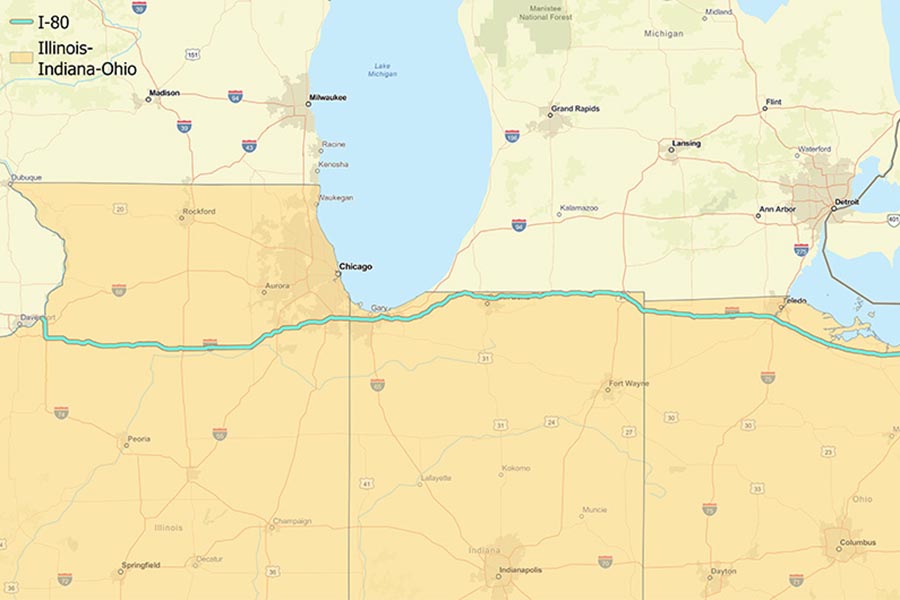$1.25 million DOE grant to develop zero-emissions infrastructure plans for the I-80 Midwest corridor

The Department of Energy has awarded a Purdue University team and Cummins, Inc., a $1.25-million grant to develop two action plans for zero-emission infrastructure along the I-80 Midwest corridor. The plans focus on near- and longer-term electrified infrastructure and alternative fueling solutions for heavy-duty commercial vehicles to improve the air quality for communities near the interstate and lead the charge toward a zero-emissions future.
“We will provide a near-term deployment plan by 2025 that looks at high-power in-route electric vehicle (EV) charging to support fleet electrification,” said Nadia Gkritza, lead for the Purdue project team and professor of civil engineering and agricultural and biological engineering at the Lyles School of Civil Engineering. “We’re also looking longer term, by 2035 or longer, and comparing the kinds of infrastructure technology options we will need, like extreme fast-charging systems at the megawatt level, hydrogen fueling and dynamic wireless power transfer, a type of electrified roadway.”
Heavy vehicles and long-haul freight contribute a significant amount of carbon emissions which results in poor air quality in communities that are interstate adjacent.
“Some parts of this corridor have maybe 70,000 heavy-duty trucks going over it every single day,” said Dionysios Aliprantis, a professor of electrical and computer engineering at Purdue and project team member. “The neighborhoods and towns around this corridor are at a disadvantage because they suffer high levels of pollution.”
While there have been tremendous steps in electrifying transportation for light-duty vehicles, the challenge Purdue and Cummins teams will address is how to transition electrification to heavier and medium-duty commercial vehicles and improve the uptake of these vehicles in the market.
“Infrastructure to support zero-emissions commercial vehicles is one the biggest challenges to market adoption,” said John Kresse, director of advanced electrification technologies at Cummins. “Cummins is interested in understanding and helping improve access to this infrastructure (EV charging and H2 refueling) for our fleet customers.”
The project team will develop a two-phase deployment and infrastructure plan to make the I-80 Midwest corridor zero emissions. The first phase is a near-term deployment plan that looks at high-power in-route EV charging to support battery electric fleet electrification by 2030. The team will use existing transportation data provided by the Indiana Department of Transportation (INDOT) to evaluate the impact of new electrification technology on mobility, energy use, and emissions.
The second phase is longer term and will explore what electrifying the corridor looks like 10 or 15 years in the future. The team will compare advanced infrastructure technologies, including fast-charging EV systems called megawatt charging, hydrogen refueling, and dynamic wireless power transfer, aka “electrified roadways,” to investigate alternative solutions to improve the sustainability of the corridor’s infrastructure.
“The professors and graduate students from Purdue have experience in EV charging through their ongoing work with the ASPIRE NSF-funded research center and the INDOT-Purdue dynamic wireless power transfer project,” Kresse said. “We have confidence in their ability and in their existing relationship with INDOT, who is also a partner on the project. Plus, this work is focused on I-80 in the Midwest and highways in Indiana, so it helps to have a local university directly involved.”
In addition to Cummins and INDOT, the Purdue project team is also working with several community, education, and metropolitan planning organizations to understand how an electrified infrastructure will impact surrounding communities.
“Some of the things we focus on are community engagement and looking for ways electrified transportation systems can be beneficial to communities who are often marginalized, underserved, or minoritized,” said Brandon Allen, associate research faculty in engineering education at Purdue and project member. “We want to think about who has access to charging stations and the environment and air quality. We can’t do these solutions without community involvement and educating the workforce, so we’re hitting both sides of the aisle. It’s a holistic approach.”
Other partners for this project include Argonne National Laboratory, National Renewable Energy Laboratory, Indiana Department of Transportation, Chicago Metropolitan Agency for Planning, NIPSCO, Pilot Travel Centers, the Indiana Motor Truck Association, CALSTART, Greater Indiana Clean Cities, and Drive Clean Indiana nonprofits.
The collaborative project between Cummins and Purdue is only the start of bringing the heavily traveled I-80 corridor closer to zero emissions and improving air quality for surrounding communities.
“Knowing that the roll-out of zero emissions infrastructure will be a multi-decade process, we hope this project allows the strengthening of relationships between the wide range of project partners and stakeholders for future work,” Kresse said. “This project is just a beginning.”
The project is one of two involving teams from the National Science Foundation ASPIRE Engineering Research Center that received DOE funding for EV infrastructure planning to help drive the nation closer toward a zero emissions future. A second project, titled Wasatch Front Multimodal Corridor Electrification Plan, is led by Utah State University and ASPIRE teams and will develop a community, state and industry action plan to improve air quality in communities most impacted by high-density traffic in the greater Salt Lake City region.
